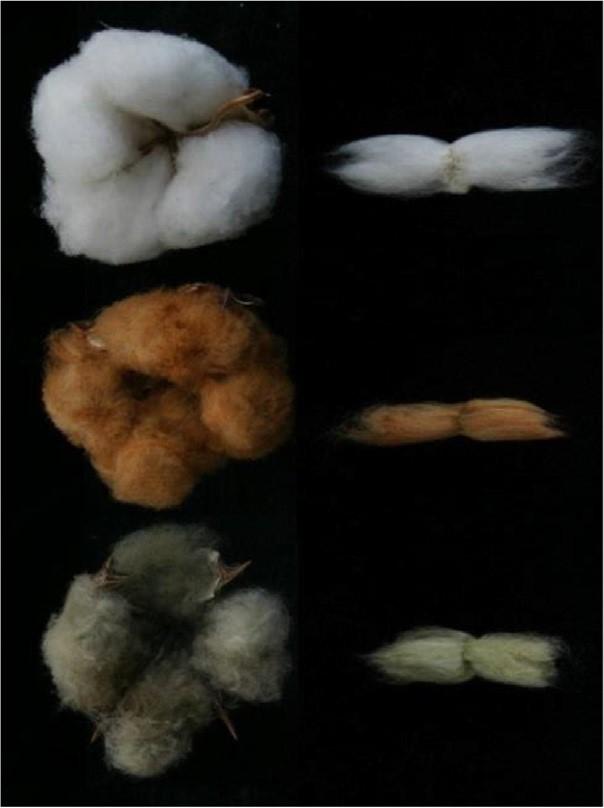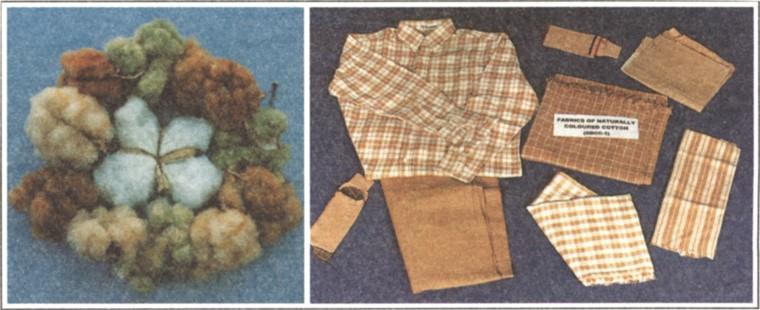“Food, clothing, housing and transportation” are the basic guarantees of people’s lives, and the main source of “clothing” is cotton, the largest raw material in the textile industry. The cotton fibers grown in the fields are usually snow-white, and what we can actually see are people wearing colorful clothes. These colorful fabrics are mainly formed from cotton textile fabrics that are processed through industrial printing and dyeing. In fact, there is also a type of natural colored cotton in nature, which can form colored fabrics without printing and dyeing, that is, natural colored cotton.
What is natural colored cotton?
Currently, natural colored cotton mainly includes two categories: brown cotton and green cotton (Figure 1). Natural colored cotton is due to the fact that cotton fiber cells can produce pigment substances during the differentiation and development process, and the pigment substances can Accumulate in fiber cells to form colored fibers.

Figure 1 White cotton, natural brown cotton and natural green cotton (picture provided by Professor Sun Jie of Shihezi University)
Natural colored cotton is an important germplasm resource in cotton. Cotton cultivation and breeding have a long history. Natural colored cotton has a history of nearly 5,000 years. Naturally colored cotton began to be cultivated in Peru about 4,000 years ago. However, colored cotton was gradually eliminated from production due to its poor quality and unstable color.
In the early 1960s, people re-recognized the importance of colored cotton, and 18 countries including the United States, Egypt, and Peru successively carried out research and development of colored cotton. In the early 1980s, Fox, a colored cotton breeder in the United States, introduced colored cotton grown by Central American Indians and hybridized it with local long-fiber white cotton to create yellow, brown, red and green long-fiber natural colored cotton.
my country began to collect colored cotton germplasm resources in the 1970s. Initially, a batch of colored cotton germplasm resources were introduced from the United States. Academy of Agricultural Sciences, etc.) and joint company (China Colored Cotton Co., Ltd.) researched and obtained many natural colored cotton varieties.
What are the advantages of natural colored cotton?
Natural colored cotton does not require printing and dyeing processing to present natural colors. Therefore, it does not contain chemical dyes, does not produce azo compounds, does not contain toxic compounds such as formaldehyde, and is especially suitable for textile underwear. It has a soft and soft texture. The advantage of comfortable wearing (Murth, Figure 2); colored cotton does not require bleaching, printing, dyeing, disinfection and other processing processes during processing, reducing labor input and the use of chemical dyes, and will not form chemical pollution and chemical residues during processing. Such natural colored fibers can be landfilled and will not cause pollution to the environment. They are environmentally friendly raw materials. In addition, natural brown cotton has natural antibacterial properties and good fire resistance.

Figure 2 Natural colored cotton and its textiles
Where did colored cotton come from and where will it go?
Judging from the long history of planting colored cotton and the brown color of many wild cotton fibers, colored cotton has been around since ancient times. Researchers and breeders often find that white cotton can mutate into brown cotton and green cotton in the field. cotton.
In recent years, the Cotton Research Institute of the Chinese Academy of Agricultural Sciences, Southwest University, Huazhong Agricultural University and Shihezi University have all made important contributions to colored cotton breeding and basic research, especially the identification of brown cotton target genes and passed Genetic engineering resulted in brown transgenic cotton.
In the future, color genes transferred into cotton endogenous or exogenous species through genetic engineering may be able to obtain more colorful cotton varieties, thereby providing the textile industry with more textile fabrics that do not require printing and dyeing, and providing our country with Make a contribution to realizing an environmentally friendly society and carbon neutrality.







